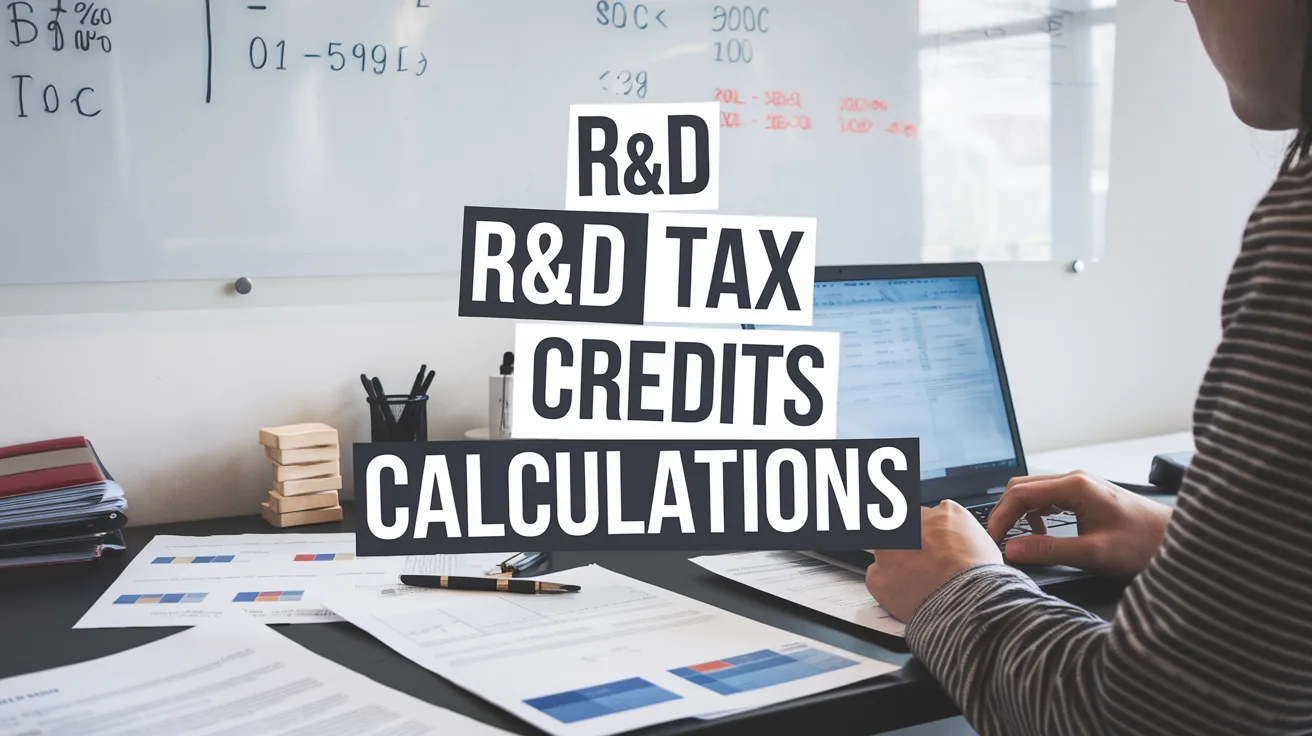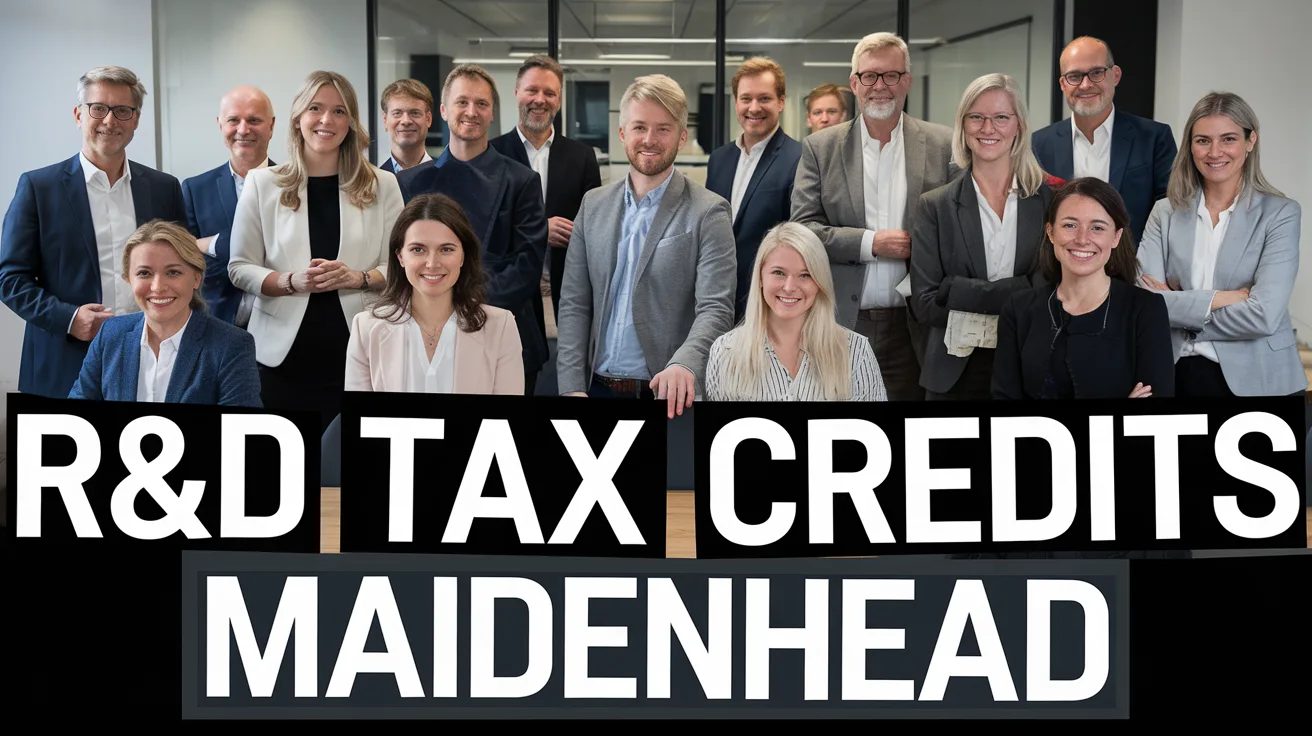R&D Tax Credits Maidenhead Berkshire
R&D tax credits in Maidenhead, Berkshire, are a valuable incentive designed to reward businesses for their investments in research and development activities. These credits can significantly reduce your tax liability and increase your cash flow. HMRC provides these credits to encourage businesses to invest in innovation and development, supporting companies in offsetting a portion of their research and development expenses.
By claiming R&D tax credits, Maidenhead businesses can benefit financially by receiving a significant portion of their R&D expenditure as tax relief. UK companies can receive a benefit of up to 27% of their qualifying R&D expenditure, which can be used to reduce their Corporation Tax bill or even result in a payable tax credit. This financial relief is crucial for businesses looking to accelerate their R&D activities, hire new staff, and ultimately grow their operations, driving innovation and competitiveness in sectors such as technology, manufacturing, and life sciences.

How Do R&D Tax Credits Benefit Maidenhead Businesses?
R&D tax credits significantly benefit Maidenhead businesses by providing a valuable source of funding for innovation and reducing their tax liability. This incentive encourages businesses to invest in research and development, driving growth and competitiveness.
Financial Advantages
R&D tax credits offer financial advantages to Maidenhead businesses by allowing them to claim a significant portion of their R&D expenditure as a tax relief. UK companies can receive a benefit of up to 27% of their qualifying R&D expenditure, which can be used to reduce their Corporation Tax bill or even result in a payable tax credit.
This financial relief can be substantial, with the average R&D tax credit claim under the SME scheme being around £81,000, according to HMRC statistics. This funding can be crucial for businesses looking to accelerate their R&D activities, hire new staff, and ultimately grow their operations.
Competitive Edge in Innovation
R&D tax credits give Maidenhead businesses a competitive edge in innovation by incentivizing them to develop new products, processes, or services. By supporting these innovative activities, businesses can stay ahead in their respective industries, whether it be in manufacturing, information and communication, or professional, scientific, and technical sectors.
This support for innovation can lead to positive changes not only for the business but also for the wider economy and society. It encourages businesses to invest in new technologies and processes, which can result in improved products, enhanced efficiency, and overall economic growth.

Which Industries Commonly Claim R&D Tax Credits?
Companies across various industries in the UK can claim R&D tax credits, but some sectors are more prevalent in doing so. The technology sector, manufacturing industry, and life sciences sector are among the most active in claiming these credits.
Technology Sector
The technology sector, including software development and IT, is a significant beneficiary of R&D tax credits. Companies in this sector often engage in activities such as developing new software tools, improving data capture and transmission methods, and testing innovative technological processes. For instance, software developers can claim back costs for projects aimed at advancing computer science or information technology.
Manufacturing
The manufacturing industry is the largest sector claiming R&D tax credits, with companies frequently developing or improving products, materials, and processes. This includes using computer-aided tools for product development, creating second-generation products, and adapting to regulatory changes. Industries like aerospace, automotives, and electronics are particularly active in these types of projects.
Life Sciences
The life sciences sector, encompassing healthcare and pharmaceuticals, heavily relies on R&D to innovate and improve services, products, and treatments. Activities such as developing software solutions for electronic medical records, testing new product prototypes, and reducing side effects of pharmaceuticals are common qualifying R&D activities in this sector.
Others
Other industries also benefit significantly from R&D tax credits. For example, the construction industry invests in R&D to improve efficiency and comply with regulatory standards, while the farming and agriculture sector develops new machinery and processes to enhance production efficiency. Additionally, sectors like oil and gas, energy, and professional, scientific, and technical services also engage in qualifying R&D activities.

What Qualifies as R&D Under UK Tax Law?
To qualify as research and development (R&D) under UK tax law, your project must seek an advance in science or technology and overcome scientific or technological uncertainties that are not readily deducible by a competent professional in the field.
Qualifying Activities
Qualifying R&D activities involve projects that aim to achieve an advance in overall knowledge or capability in a field of science or technology. This includes:
- Developing new or improved products, tools, or services that overcome technological challenges.
- Modifying existing processes or production lines to increase efficiency or solve technological problems.
- Resolving scientific or technological uncertainties where the solution is not readily available or deducible by a competent professional.
These activities can span various industries, including manufacturing, information and communication, and professional, scientific, and technical sectors.
Excluded Activities
Activities that do not qualify as R&D include:
- Work in the arts, humanities, and social sciences (including economics), as these do not constitute scientific or technological innovations.
- Projects that are commercially innovative but do not involve an advance in science or technology.
- Routine or periodic changes to existing products or processes that do not overcome significant technological uncertainties.
These exclusions ensure that only projects that genuinely advance science or technology are eligible for R&D tax relief.

How Are R&D Tax Credits Calculated?
R&D tax credits are calculated based on the qualifying research and development expenditure incurred by your company. The calculation process differs depending on whether your company falls under the SME Scheme or the RDEC Scheme.
SME Scheme
For Small and Medium Enterprises (SMEs), the calculation involves enhancing the qualifying R&D expenditure. If your company is profitable, you can claim back up to 24.7% of your R&D expenditure. Here’s a simplified example:
- If you spent £100,000 on qualifying R&D activities, you would enhance this to £130,000 (130% of the original expenditure).
- You would then apply the corporation tax rate (19% until April 2023, and 25% thereafter for companies with annual profits over £50,000) to this enhanced amount, resulting in a claim value of £24,700 or £32,500 respectively.
For loss-making SMEs, the process involves surrendering the enhanced R&D relief for a cash credit. For example:
- £100,000 spent on R&D is enhanced to £130,000.
- This enhanced amount plus the original expenditure (£230,000) is then multiplied by the surrender rate (14.5%), resulting in a cash credit of £33,350.
RDEC Scheme
For larger companies or those that do not qualify under the SME Scheme, the Research and Development Expenditure Credit (RDEC) applies. Here, you can claim up to 15% of your qualifying R&D expenditure as a taxable credit, effective from April 1, 2023. Previously, this rate was 10%.
- For example, if you spent £1,000,000 on qualifying R&D activities, you would claim £150,000 (15% of the expenditure). After accounting for corporation tax, the net claim value would be £127,500.

What Are the Recent Changes to UK R&D Tax Credits?
The UK has introduced significant changes to its Research and Development (R&D) tax credit schemes, effective from April 1, 2024, aimed at simplifying the system and encouraging more investment in innovation. These changes include the merger of the SME and RDEC schemes into a single scheme.
Policy Updates
- Merger of Schemes: The SME and RDEC schemes have been merged into a single scheme for accounting periods starting on or after April 1, 2024, to streamline the relief and reduce costs.
- New Tax Credit Rates: A 20% R&D tax credit rate will apply to the merged scheme, while loss-making R&D intensive SMEs will receive a 27% tax credit.
- R&D Intensity Threshold: The threshold for R&D intensive SMEs has been reduced from 40% to 30% of total expenditure spent on R&D.
- Claims Process: All R&D claims must be submitted online, and additional information, such as a breakdown of R&D expenditure, must be provided to support claims.
- Subcontracting Rules: Overseas costs for externally provided workers, subcontractors, and contributions to independent R&D are no longer eligible, except where it is wholly unreasonable to replicate the conditions in the UK.
- Grace Period: Companies that fail to meet the R&D intensity threshold due to unexpected circumstances will be given a one-year grace period to maintain their R&D intensive status.
Impact on Businesses
- Simplified Claims: The merger of the schemes is expected to reduce errors and simplify the claims process for businesses, although the process remains complex and may require expert advice.
- Increased Incentives: The changes aim to reduce the cost of innovation and encourage businesses to spend more on R&D, aligning with the government's target to raise investment in R&D to 2.4% of GDP by 2027.
- Financial Impact: The new rates and rules may significantly affect the financial projections and tax relief amounts for businesses, particularly for loss-making R&D intensive SMEs which can now claim a higher rate of relief.
- Administrative Changes: Businesses will need to adapt to new administrative requirements, such as digital submission of claims and providing detailed breakdowns of R&D expenditure, to ensure compliance with the new rules.

How Can Maidenhead Businesses Apply for R&D Tax Credits?
To apply for R&D tax credits, Maidenhead businesses need to ensure they meet the eligibility criteria set by HMRC and follow the specific application process. This involves identifying qualifying R&D activities and submitting the necessary documentation.
Application Process
- Notify HMRC: If your company has not previously claimed R&D tax relief or has not claimed within the last three years, you must notify HMRC within six months of the end of the accounting period in relation to which the R&D is incurred.
- Determine the Scheme: Decide whether your company qualifies under the SME R&D tax credit scheme or the Research and Development Expenditure Credit (RDEC) scheme, based on your company's size and other factors.
- Identify Qualifying Expenditure: Document the uncertainties and planned innovation at the start of the project. Identify direct and indirect activities related to the R&D project, such as staff costs, software, and consumables.
- Calculate the Relief: Calculate the R&D tax relief accurately, taking into account the applicable scheme. For SMEs, this could involve an enhancement rate and a tax credit rate, while for larger companies, it involves a taxable credit under the RDEC scheme.
- Submit the Claim: Include the R&D tax relief claim in your corporation tax return. Ensure all necessary information and documentation are provided to support the claim.
Required Documentation
- Technical Narratives: Prepare detailed technical narratives explaining the scientific or technological uncertainties and how they were addressed. This documentation should outline the innovation and the process of resolving the uncertainties.
- Financial Records: Gather and submit financial records that detail the qualifying R&D expenditure. This includes costs such as staff salaries, materials, and software.
- Project Descriptions: Provide clear descriptions of the R&D projects, including the objectives, the methods used, and the outcomes. This helps in demonstrating that the activities qualify for R&D tax relief.
- Supporting Evidence: Ensure you have supporting evidence for all claims, such as timelines of activities, records of meetings, and any other relevant documentation that shows the R&D work was undertaken.
By following these steps and ensuring you have the necessary documentation, Maidenhead businesses can effectively apply for and benefit from R&D tax credits.

What Common Mistakes Should Be Avoided When Claiming?
When claiming expenses or income on your tax return, it is crucial to avoid mistakes that can lead to penalties, delays, or even legal issues. Here are some key areas to focus on to ensure accuracy and compliance.
Overclaiming
Overclaiming expenses or income can lead to serious consequences, including penalties and potential audits. For instance, HMRC strictly requires that business expenses be "wholly and exclusively for trade" purposes. Claiming personal expenses as business expenses or including expenses that are not entitled can result in incorrect information on your tax return, which may trigger a considerable penalty.
Underclaiming
Underclaiming expenses can result in an unnecessarily high tax bill. It is essential to familiarize yourself with the list of allowable expenses to ensure you claim everything you are entitled to. For example, if you are self-employed, you can deduct expenses such as office supplies, travel, and equipment, but you must keep clear records to justify these claims.
Documentation Errors
Documentation errors are a common pitfall when claiming expenses or income. Missing or incorrect information, such as a Unique Taxpayer Reference (UTR) or National Insurance (NI) number, can prevent HMRC from processing your tax return. Additionally, failing to include supplementary pages, such as SA102 for employees or SA103S for self-employed individuals, can lead to complications and delays.
Ensuring all necessary documentation is complete and accurate, including proof of expenses and income sources, is vital to avoid any issues with your tax return. Keeping accurate records and double-checking all information before submission can help you avoid these common mistakes.

How Can Professional Advice Enhance R&D Tax Credits Claims?
Professional advice can significantly enhance your R&D tax credits claims by ensuring you maximize your entitlement and comply with all the necessary regulations. Experts in R&D tax credits can help you identify all qualifying activities and expenses, manage the claim process efficiently, and avoid potential errors or penalties.
Role of Tax Credit Specialists
R&D Tax Credit Specialists play a crucial role in helping businesses navigate the complex process of claiming R&D tax credits. Here are some key aspects of their role:
- Identify Qualifying Projects: Specialists help determine which of your projects meet the criteria for R&D tax credits, such as seeking an advance in science or technology and overcoming scientific or technological uncertainties.
- Calculate Qualifying Expenditure: They assist in calculating the qualifying R&D expenditure, including costs such as employee wages, supplies, equipment, and sub-contracted labour.
- Manage Claim Process: Specialists handle the paperwork and liaise with HMRC on your behalf, ensuring the claim process is smooth and efficient.
- Ensure Compliance: They keep up-to-date with the latest regulations and ensure that your claims comply with HMRC requirements, reducing the risk of errors or penalties.
- Maximize Claims: By understanding the nuances of the R&D tax credit schemes, specialists can help you claim the maximum amount you are entitled to, whether through the SME scheme or the RDEC scheme.
Benefits of Expert Guidance
Using expert guidance from R&D Tax Credit Specialists offers several benefits:
- Time Savings: Experts handle the complex paperwork and administrative tasks, saving you time to focus on driving innovation and growth within your business.
- Accuracy and Compliance: Specialists ensure that your claims are accurate and comply with HMRC regulations, avoiding any potential penalties or delays.
- Maximized Savings: With their expertise, you can ensure that you are claiming the full amount of R&D tax credits you are eligible for, which can range from £10,000 to several hundred thousand pounds.
- No-Win-No-Fee Model: Many specialists work on a no-win-no-fee basis, meaning you have nothing to lose by seeking their advice.
In Conclusion
R&D tax credits in Maidenhead, Berkshire, are a powerful incentive designed to reward businesses for their investments in research and development activities. These credits, provided by HMRC, can significantly reduce your tax liability and increase your cash flow, thereby fostering innovation and growth.
Financial and Innovative Benefits
R&D tax credits offer substantial financial benefits to Maidenhead businesses by allowing them to claim a significant portion of their R&D expenditure as tax relief. This can result in a reduction of up to 27% of the qualifying R&D expenditure, which can be used to offset Corporation Tax liabilities or even received as a cash refund for loss-making companies. This financial relief encourages businesses to invest more in innovative projects, such as developing new software, enhancing existing technologies, or integrating solutions from existing technologies to create new products.
Simplified and Enhanced Benefits
Recent changes to the R&D tax credit system, including the merger of the SME and RDEC schemes from April 2024, aim to simplify the claims process and reduce fraud. The new scheme will provide a uniform rate, making it easier for businesses to navigate and claim relief. For instance, the RDEC rate has increased to 20% for expenditure incurred on or after April 1, 2023, benefiting larger companies significantly.
Actionable Steps
To maximize the benefits of R&D tax credits, it is crucial to ensure you meet the eligibility criteria and follow the correct application process. R&D Tax Credit Specialists can guide you through this complex process, helping you identify qualifying activities, calculate your claims accurately, and ensure compliance with HMRC regulations. By leveraging their expertise, you can optimize your claims, reduce complexity, and ensure you are maximizing your eligible expenses.
If you are a business in Maidenhead, Berkshire, investing in innovation, do not miss out on the opportunity to claim R&D tax credits. Contact R&D Tax Credit Specialists today to ensure you are taking full advantage of these valuable incentives and navigating the application process efficiently. Their expert guidance can help you enhance your business's financial health and innovation capabilities.

